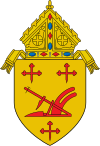St. Joseph's Catholic Church (Wapakoneta, Ohio)
St. Joseph Catholic Church and School | |
| NRHP reference No. | 79003453[1] |
|---|---|
| Added to NRHP | July 26, 1979 |
St. Joseph's Catholic Church is a historic Roman Catholic church in Wapakoneta, Ohio, United States. Built in 1910, this church is home to an active Catholic parish, and it has been declared a historic site because of its well-preserved Romanesque Revival architecture.
Early parish history

One of the first two Catholic priests in northern Ohio was John William Horstmann, a native of Osnabrück who had settled in the village of Glandorf to the north. Starting in 1832, he made monthly journeys of 50 miles (80 km) to Stallotown to the south.[2]: 7 As Wapakoneta lies midway between these communities, he often visited with and celebrated Mass for its few Catholic families.[3]: 324 After four years of these travels, he established a parish at Petersburg,[2]: 7 approximately 4 miles (6.4 km) south of Wapakoneta.[4]
By 1839, the Catholic community in Wapakoneta had grown to the point that it could be created a separate parish,
Church building

By the late 1850s, the parish's membership had grown significantly, and the original church had become too small;
Architectural historians have divided the Precious Blood-related churches of western Ohio into multiple generations. Only a few buildings remain from the first generation, which consisted primarily of small wooden churches, and only St. John's Church in Fryburg remains essentially unchanged. Replacing these wooden buildings were the churches of the second generation, which were generally small brick buildings without tall spires. The churches of the third generation are mostly High Gothic Revival structures with tall towers, but the final generation of churches includes a wide range of styles. As a Romanesque Revival church built in 1910, St. Joseph's is one of the newest churches in the region, and it plainly is a part of the final generation.[2]: 2–3
Related buildings
School

In 1853, the church purchased a frame building adjacent to its property and quickly opened a parish elementary school inside. After sixteen years, a larger structure was desired, and a larger brick building was erected immediately to the east of the church at a cost of $4,000. Continued growth necessitated its replacement by a newer building in 1899; this structure is still standing.[6] With features such as towers and turrets, St. Joseph's School is one of the most architecturally-prominent Catholic schools in the region, along with schools in Minster, St. Henry, and Chickasaw.[2]: 4
As the parish continued to expand, a high school was opened in 1919; its classes met in the elementary school building until a new building was completed in 1961. However, financial issues caused the high school's closure in 1974; the elementary students were then transferred to the former high school, and the original elementary school was then leased to the Wapakoneta City School District.[6]
Rectory
As well as completing its school in 1899, the parish also built a
Recent history

Current condition
Today, St. Joseph's Church is an active parish of the Archdiocese of Cincinnati. It is clustered with St. John parish in Fryburg, and the entire cluster is part of the St. Marys Deanery.[8]
Recognition
In 1979, St. Joseph's Church and School were listed on the
References
- ^ a b c "National Register Information System". National Register of Historic Places. National Park Service. March 13, 2009.
- ^ a b c d e Brown, Mary Ann and Mary Niekamp. National Register of Historic Places Inventory/Nomination: Cross-Tipped Churches Thematic Resources. National Park Service, July 1978. Accessed 2009-11-21.
- ^ a b c d McMurray, William J., ed. History of Auglaize County Ohio. Vol. 1. Indianapolis: Historical Publishing Company, 1923.
- ISBN 0-89933-281-1.
- ^ Fortin, Roger. Faith and Action: A History of the Archdiocese of Cincinnati 1821-1996 Archived 2011-07-27 at the Wayback Machine. Columbus: Ohio State UP, 2002, 400.
- ^ a b c d e f g Fullenkamp, Leonard. "History of St. Joseph Catholic Parish". Auglaize County Historical Society, ed. A History of Auglaize County Ohio. Defiance: Hubbard, 1980, 103-104.
- ^ Ohio Historical Society, 2007. Accessed 2010-06-20.
- ^ The Futures Project, Archdiocese of Cincinnati. Accessed 2010-06-20.






